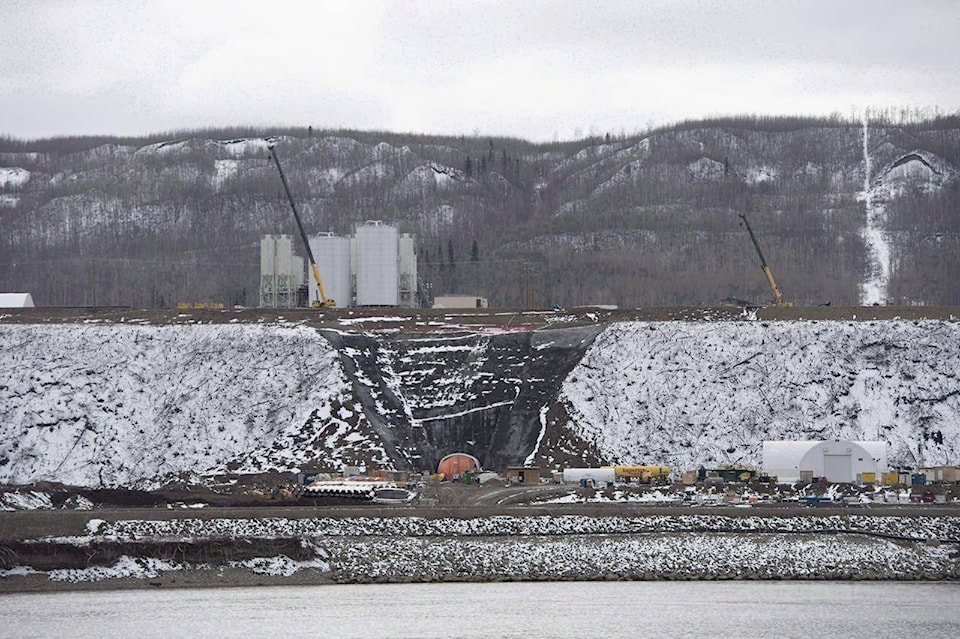A controversial hydroelectric project in northern B.C. will be billions of dollars over budget and won’t be operational until 2025, according to an update from Premier John Horgan.
The Site C project on the Peace River, is now expected to cost $16 billion and is over halfway complete and geotechnical challenges on the right bank of the project has slowed progress, as expert reviews were needed to ensure necessary foundation enhancements can support construction of the dam.
During a press conference on Friday, Premier Horgan also said the provincial government and BC Hydro has accepted 17 recommendations from Peter Milburn, who led a team conducting an independent review last year, which will improve oversight, risk management and governance of the project.
“Today I am confirming that the Site C energy project will be completed,” said Premier Horgan. “That decision came through due diligence and care and deliberation on what was in the best interests of all British Columbians and I believe today we’ve made the right decision.”
Hogan also announced a change of leadership at BC Hydro’s board of directors, announcing the appointment of Doug Allen as the new board chair, replacing Ken Peterson.
The costs to cancel the project, including costs already incurred and costs to remediate the land, would run to $10 billion. Cancelling the project would impact the workforce of 4,500 and cause electricity rates to rise significantly, according to Premier Horgan.
Horgan said managing the main civil works contract that was signed by the previous BC Liberal government has caused some issues and transfers much of the geotechnical risks associated with the project back to BC Hydro. Horgan added that the COVID-19 pandemic has also presented construction delays and challenges.
BC Liberal critic responds
Kootenay East MLA Tom Shypitka said Site C going ahead is a “good thing” but accused the provincial NDP of mismanaging the project doubling the costs from $8 billion to $16 billion
“That’s a big number when you’re talking billions of dollars,” said Shypitka, the BC Liberal critic for energy and mines. “We’re not too happy with the cost overruns and we’re not happy with the lack of transparency that government has provided throughout this whole process.”
While Premier Horgan put some of the blame of the project’s woes at the feet of the previous B.C. Liberal government, Shypitka said the NDP previously told the legislature that the project would be on time and on budget in 2017.
“Since that time, it’s gone from an $8.5 billion project to now $16 billion,” Shypitka said. “Somewhere, between on time and on budget, has happened to be mismanagement and over-budget. That didn’t happen under our watch, that was 100 per cent under their watch.
“The lack of transparency, the missing quarterly reports from BC Hydro…this veil of secrecy and lack of transparency to the taxpayers of British Columbia should be an outrage to people.”
Many of Milburn’s recommendations focused on oversight of the project, particularly with respect to BC Hydro and risk management strategies.
Shypitka says time will tell if the province has made enough changes to keep the project on track.
“I don’t know what the future brings,” Shypitka said. “I know what the past has brought us, the past has brought us mismanagement, not only on Site C, but many other projects in B.C. over the last four years. I’m fearful that this may not be the end of it. I hope I’m wrong, because I don’t want to see that for anybody.”
Site C timeline
Site C construction began in 2015, with more than 50 per cent of the project completed to date, employing approximately 4,500.
The Peace River was diverted last fall into two 750-metre long tunnels, which will facilitate construction of an earthfill dam on dry land.
Construction work is ongoing for the powerhouse and penstocks - large steel pipes that carry water from the reservoir to the power generating turbines — are more than halfway finished.
COVID-19 had a significant impact on construction last year, which scaled back activity and is pushing the completion date ahead by a year to 2025.
This year, areas of focus will be the earthfill dam, powerhouse, intakes, penstocks, and finishing a second transmission line between the Peace Canyon generating station to the Site C substation, among other priorities.
Upon completion, the dam will provide 1,100 megawatts, and produce 5,100 gigawatt hours — enough to power 450,000 homes.
While billed as a clean energy project, Site C has also been criticized for displacing residents in the Peace River Valley and destroying wildlife habitat and traditional Indigenous territory.
trevor.crawley@cranbrooktownsman.com
Like us on Facebook and follow us on Twitter
Want to support local journalism during the pandemic? Make a donation here.
